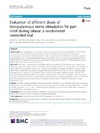Please use this identifier to cite or link to this item:
https://accedacris.ulpgc.es/handle/10553/54965
| Title: | Evaluation of different doses of transcutaneous nerve stimulation for pain relief during labour: A randomized controlled trial | Authors: | Báez Suárez, Aníbal Martín Castillo, Estela María García Andújar, Josué Bernardo García Hernández, José Ángel Quintana Montesdeoca, María Del Pino Loro-Ferrer, Juan Francisco |
UNESCO Clasification: | 320108 Ginecología 3209 Farmacología |
Keywords: | 1St Stage Tens Mechanisms Analgesia Transcutaneous Electrical Nerve Stimulation, et al |
Issue Date: | 2018 | Journal: | Trials | Abstract: | Background: Pain during labour is one of the most intense pain that women may experience in their lifetime. There are several non-pharmacological analgesic methods to relieve pain during labour, among them transcutaneous electrical nerve stimulation (TENS). TENS is a low-frequency electrotherapy technique, analgesic type, generally used in musculoskeletal pathology, but it has also come to be used as an alternative treatment during labour. The purpose of this study is to investigate the pain-relieving effect of a TENS application during labour and to find out the most effective dose.Methods: This study is a randomized, double-blind, placebo-controlled trial. TENS therapy was initiated at the beginning of the active phase of labour. Participants were randomly assigned to three groups (21 per group: two active TENS and one placebo). Active TENS 1 intervention consisted in a constant frequency of 100-Hz, 100-mu s, active TENS 2 intervention consisted in a varying high-frequency (80-100Hz), 350 s, and in a placebo group, participants were connected to the TENS unit without electrical stimulation. TENS was applied with two self-adhesive electrodes placed parallel to the spinal cord (T10-L1 and S2-S4 levels). The primary outcome was pain intensity (0-10cm) measured on a visual analogue scale (VAS) at several stages (at baseline and at 10 and 30 min later). Secondary outcomes included women's satisfaction (via the Care in Obstetrics: Measure for Testing Satisfaction scale).Results: Sixty-three women participated. Regarding baseline characteristics, no differences were found among the three groups. The active TENS 2 group obtained an improvement with clinically significant VAS results (-2.9, 95% confidence interval -4.1 to -1.6, p<0.001). Regarding satisfaction, the results also revealed better results in the active TENS than in the placebo group.Conclusions: TENS with high frequencies modified in time as well as high pulse width are effective for relieving labour pain, and they are well considered by pregnant participants. | URI: | https://accedacris.ulpgc.es/handle/10553/54965 | ISSN: | 1745-6215 | DOI: | 10.1186/s13063-018-3036-2 | Source: | Trials [ISSN 1745-6215], v. 19(1), (Noviembre 2018) |
| Appears in Collections: | Artículos |
SCOPUSTM
Citations
25
checked on Jun 8, 2025
WEB OF SCIENCETM
Citations
22
checked on Jun 8, 2025
Page view(s)
99
checked on Mar 9, 2024
Download(s)
118
checked on Mar 9, 2024
Google ScholarTM
Check
Altmetric
Share
Export metadata
Items in accedaCRIS are protected by copyright, with all rights reserved, unless otherwise indicated.
